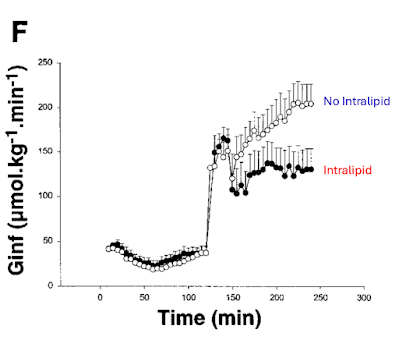The most serious tool available to the Shulman lab in both the
2016 and
2021 studies was a mouse strain in which they had replaced the Thr
1150 (the mouse equivalent of the human Thr
1160) of the insulin receptor with an alanine. Alanine is a threonine with the hydroxyl group removed and the side chain shortened by one carbon atom. There is nowhere to place a phosphate group on an alanine, so these mice are unable to develop pThr
1150 induced insulin resistance. Nowhere to place an appropriate phosphate = no pThr
1150 insulin resistance.
With zero pThr1150 derived insulin resistance they had a rock steady standard of high insulin sensitivity against which to compare other less insulin sensitive states, using basic tools such as an hyperinsulinaemic euglycaemic clamp, glucose uptake, pAKT etc.
It turned out to be easy to demonstrate that these alanine substituted mice were perfectly capable of maintaining hepatic insulin sensitivity despite increased hepatic triglyceride/diglyceride content when fed D12492, much as you would expect in the absence of a phosphorylatable Thr1150.
The problem was that the group was unable to demonstrate any adipocyte insulin resistance at all after a week of feeding D12942 to their control mice. You would have thought that a week of "overnutrition" would, if you were Shulman, make adipocytes insulin resistant.
So they tweaked the hyperinsulinaemic euglycaemic clamp conditions to allow them to look for more subtle signs of preserved insulin sensitivity in the Thr1150/alanine mice or, more accurately, of active insulin resistance in the control mice. As they state:
"In our previous study, we did not observe any protective effects on WAT insulin action in HFD-fed InsrT
1150A mice (
6). However, these assessments of WAT metabolism were performed during the final stages of a 140-minute HEC with an insulin infusion rate at 2.5 mU/(kg•min). Suppression of WAT lipolysis occurs rapidly after the onset of hyperinsulinemia (
16), and the degree of WAT insulin resistance after just several days of HFD feeding is subtle and can be surmounted with high plasma insulin concentrations. Thus, any differences in WAT lipolysis may have been obscured in our previous studies involving the InsrT
1150A mice.
In order to address this possibility, we performed a much shorter 30-minute HEC study with a lower-dose insulin infusion rate (2.0 mU/[kg-min]) to evaluate insulin action in WAT in InsrT
1150A mice subjected to 7-day HFD."
They did two things at the same time, one was to reduce the dose of insulin used in the clamp and the second was to shorten the duration of the clamp from 140 minutes to 30 minutes.
They ran in to problems doing this. The biggest is that, if you slog through supplementary data to the first paper in 2016, you get this chart:
which gives you an insulin concentration in plasma of around 30μU/ml, or, as we say in the rest of the world, 210pmol/l, ie a modest fed-state value was used as the clamp level. That's a very low insulin level for a clamp, they're already looking for subtleties. This the *high* infusion rate value from 2016. Once they had dropped the insulin infusion rate and changed the measurement point to 30 minutes rather than 140 minutes, they got this as the clamp level of insulin in 2021, again from the supplementary data:
Here we have a clamp level of insulin, with the *reduced* infusion rate, which is *higher* than in their initial 2016 study, this time we have ~38μU/ml, ie 270pmol/l vs the 200pmol/l of the earlier study. I very much doubt that the level is actually genuinely significantly higher, statistically or biologically. It's just unchanged.
But it is certainly not lower.
Ouch.
This is actually completely plausible as the insulin level achieved with a given infusion rate will have a lot of variables which affect the end result and Shulman's group were probably simply unlucky.
So they ignored it. At least publicly.
Ouch.
So the difference in adipocyte insulin resistance between the 2016 study and the 2021 study is that, at essentially the same insulin level, things are very different depending on whether you open Schrodinger's mouse box at 30 minutes vs opening it at 140 minutes.
Let's make this absolutely clear:
Thr1150/alanine mice are never insulin resistant. Full stop.
D12942 fed mice are insulin resistant, with significantly phosphorylated Thr1150 while eating an HFD, but lose their insulin resistance at some time point between 30 minutes and 140 minutes of exposure to mildly elevated insulin in combination with normoglycaemia. This insulin resistance is present at 30 minutes. It's gone by 140 minutes. Phosphates come off of Thr1150 somewhere within this time window.
I might rephrase that in the future but it's good enough for today.
These are the core findings about adipocyte insulin resistance from the two Shulman studies. That's it.
I have come to loathe both of these studies, but, when you extract the facts from the doublespeak, they do describe reality as I see it.
Pause. Deep breath.
How well does reality comply with Shulman's data? We have this study
Resistance to symptomatic insulin reactions after fasting
As Shulman tells us, fasting phosphorylates human Thr
1160. The subjects of the above study had an insulin tolerance test before fasting and then fasted for 60 days. This is likely to have phosphorylated the Thr
1160 of their insulin receptors to the maximum physiological level possible. Under these extreme fasting conditions the insulin tolerance test was repeated. Despite the weight loss the insulin concentrations in plasma were remarkably consistent between the two tolerance tests. Kudos to whoever calculated the individualised insulin boluses.
Shulman's data tell us that we can expect, with insulin and a little glucose, to de-phosphorylate Thr
1160 to achieve a minimally insulin resistant state a time point somewhere between 30 minutes and 140 minutes after insulin exposure, pretty much independent of the insulin concentration used. This is what happens to the plasma glucose levels, the fall of which represents insulin's action, after an insulin bolus at time point zero:
In the "before fast" state there is only a modest percentage of insulin receptors with phosphorylation of Thr1160, so insulin acts rapidly to give a glucose nadir at 30 minutes.
In the "after fast" state Thr1160 of the insulin receptors are predominantly phosphorylated and it takes time to de-phosphorylate them, so the glucose nadir occurs at 60 minutes rather than at 30 minutes. Exactly in the window specified by Shulman's data but, obviously, never explicitly stated.
When I find two utterly non related studies both of which tell me the same story, I have a tendency to believe them.
Shulman actually uses this phrase (the term InsrT1150A means the Thr1150/alanine modified mouse which we have been discussing and Insr is the insulin receptor):
"Mutation of this residue from a threonine to an alanine (i.e., InsrT1150A) shields Insr from this
pathogenic phosphorylation and preserves hepatic insulin signaling and hepatic insulin sensitivity in HFD-fed mice... "
The same applies to adipocytes. My italics and my red colouration to the text for emphasis. Shulman's lab is very, very good at doing things. Understanding their own data and deriving how life works from them, not so much so.
There is no pathology here, excepting what we'll come to look at in terms of failed physiological insulin resistance under D12942.
Peter

































